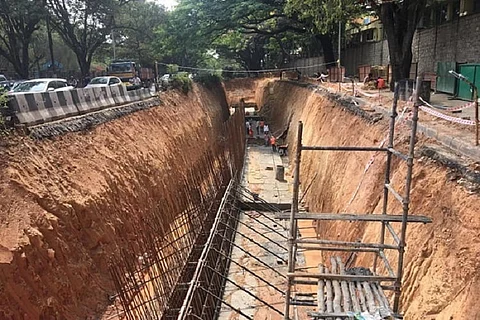

From driverless pod taxis to constructing flyovers and underpasses, Bengaluru’s civic body – the Bruhat Bengaluru Mahanagara Palike has, over the years, come up with several hare-brained plans to reduce the city’s traffic. In another attempt to reduce the congestion on the city’s roads, the BBMP has now begun work on its signal-free corridor project.
Like many of the Palike’s projects, the signal-free corridor project too began years ago but has not yet come to fruition. The BBMP proposed the plan in 2014. The signal free-corridor was to stretch between Army Service Corps Centre and Hope Farm Junction in Whitefield. The civic body had planned the construction of three underpasses for this signal-free corridor – at the ISRO junction in Marathahalli, at Suranjan Das Road Junction near HAL, and at Kundalahalli Junction on Old Airport Road.
However, the work has begun recently, and has already run into roadblocks.
In August 2018 the BBMP began constructing one of the underpasses at ISRO Junction. However, the project was halted just a month later as the workers found a 220KW Karnataka Power Transmission Corporation Ltd (KPCTL) cable. “These were electricity cables which provided power to the entire HAL area and hence, we could not continue the construction work,” a senior official with BBMP Project Central-4 Department told TNM. The work will resume only after KPCTL relocates the power lines.

ISRO Junction underpass
Similarly, BBMP officials say that the stage I of the construction of Kundalahalli underpass will be completed soon. However, the construction work had to be stopped due to problems with land acquisition.
Further, the construction work along Suranjan Das Road started only in April this year after BBMP acquired 3,100 acres of land from HAL in March.

Kundalahalli Junction underpass
The BBMP is spending Rs 109 crore for the construction of the signal-free corridor. But the larger question is – will it reduce traffic jams? Speaking to TNM, traffic expert MN Srihari says that the project is not pragmatic and is unsuitable for Bengaluru’s roads.
“The signal free corridor is not a practical idea because Indian roads mostly comprise of cross roads. Due to this, the traffic is also heavy and vehicles enter from all directions . The underpasses are being constructed at junctions. If the underpasses were being constructed on one-ways, it would have made sense. Such a concept is feasible for roads that continue for a stretch of 10-20 kms such as the New Airport Corridor, and not for roads that have cross-way traffic,” he said.
Srihari maintains that coordination of signals is a better idea and must be followed in Bengaluru to reduce bottlenecks. This means that two or more signals in a single corridor must be coordinated so that a large number of vehicles moving along one path do not get stuck at subsequent traffic signals. For instance, if a commuter who is travelling from Ulsoor to Anil Kumble Circle sees the green light at Trinity Cirlce, by the time he/she reaches Manipal Centre Circle, the traffic signal should have turned green. “Because the red and green signals are not coordinated properly, traffic jams happen,” Srihari says.